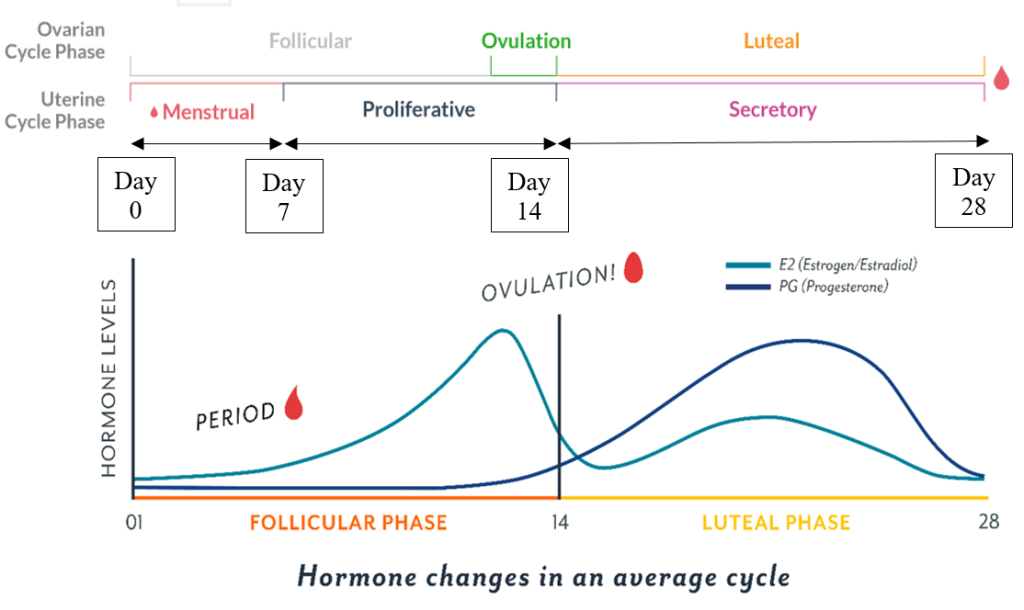[Wellbeing & You] EMBRACE Women’s Health – Part 2

Understanding Estrogen dominance, Menstrual irregularities and Breast Cancer to run the relay “RACE” of health.
Menstrual health is undoubtedly one of the most frequently asked issues when it comes to women’s health. Whether regular or irregular, delayed or frequent, menstruation has long been a trouble for many women. Since it is a complex hormonal issue, many women find themselves helpless when irregularities occur. In this second part of “Embrace Women’s’ Health”, let’s get it straight and examine in detail what is menstruation,
Keep it up!
2nd Baton to pass – Menstrual Irregularities
THE BASICS 101
What is menstruation?
Menstruation (period) is a monthly cycle where ovulation, uterine lining thickening and its subsequent shedding occur in a 28-day-cycle. Regulated by estrogen and progesterone, it is a hormonal process intended to prepare for a possible pregnancy. If no pregnancy occurs, the thickened uterine lining sheds, creating menstruation.

What actually happens from start to finish during a menstrual cycle?
Menstruation involves both organs – uterus and ovary and both hormones – estrogen and progesterone. It is commonly known as a 28-day cycle started with mensus – blood discharge (Day 0), ended right before the next mensus (Day 28) with the middle of the cycle (Day 14) marked by the date of ovulation. In terms of hormone changes, it is noted that the peak of estrogen induces ovulation while the progesterone drop induces the shedding (period).

The events and the hormonal changes of menstruation can be summarized in the below picture:

By Isometrik – Own work, CC BY-SA 3.0
Ovarian Cycle Phase: Events happen in the ovary
Uterine Cycle Phase: Events happen in the uterus.
The details of events in both ovarian and uterine cycle phases are summarized in the below table with colors corresponding to each particular phase:

| Cycle Days | Uterine Cycle Phase (Happen in the uterus) | Ovarian Cycle Phase (Happen in the ovary) |
| 0-7 | Menstrual Phase: Uterine lining sheds and there is discharge of blood | Follicular Phase: Ovary is stimulated to produce follicles. Each follicle houses an immature egg. Eventually one will become dominant follicle and the others will stop growing. |
| 8-14 | Proliferative Phase: Uterine lining grows | Follicular Phase: Dominant follicle continues to grow. |
| 14 | Proliferative Phase: Uterine lining continues to grow | Ovulation: The peak in estrogen causes the dominant follicle “bursts open” (ruptures) to release the mature egg to the uterus. |
| 15-20 | Secretory Phase: The uterine lining thickens to prepare implantation of fertilized egg. | Luteal Phase: The mature egg travels from the ovary to the uterus to prepare for fertilization and pregnancy. The emptied ruptured follicle becomes “Corpus Luteum” after releasing the egg and starts producing the hormone “progesterone” |
| 21-28 | Secretory Phase: The mature egg arrives the uterus. If the egg is fertilized, it will attach itself to the uterine lining, i.e. implantation. If there is no fertilization, the drop of progesterone in the ovarian cycle causes the uterine lining to break up, thus creating the next mensus. | Luteal Phase: If no fertilization occurs, the ruptured follicle withers and dies, progesterone drops, uterine lining sheds and discharges and the next cycle soon begins. |
Why are my periods “late” or even “absent” (no period)?
Stress and low progesterone could cause delayed/ skipped period.
- Low progesterone due to stress and could cause menstrual periods to stop
- Inhibited GnRH (Gonadotropin Releasing Hormone) by stress reduces the production of sex hormones.
- High Prolactin due to estrogen dominance and low progesterone (and also stress) inhibits ovulation as well as GnRH. In some serious cases, some people may develop prolactinoma – a type of tumor develops in the pituitary gland, which also causes delayed/ skipped periods for those patients.

Why do I have frequent periods (2 periods in 1 month) and even irregular bleeding/ spotting between periods?
Xeno (foreign) estrogen could cause frequent periods/ spotting between periods.
- Xeno-estrogen like BPA, paraben, phthalate could mimic estrogen in human body.
- Unopposed by progesterone, constant estrogen exposure could cause the uterine lining to thicken excessively, leading to frequent periods, irregular bleeding and spotting between periods.
Dietary Recommendations for better menstrual health:
- Shredded raw carrot contains insoluble fiber that can remove excess estrogen in the body.
- Antioxidant Naringenin and Apigenin can lower estrogen synthesis
- Naringenin source: Orange Juice, citrus zest (e.g. marmalade)
- Apigenin source : Guavas, Celery, Parsley
- Vitamin B6 (P5P/ Pyridoxal 5’-Phosphate) and Vitamin B9 (Methyl-Folate) increase progesterone to oppose excess estrogen. In addition, both increase dopamine, which oppose ovulation block by prolactin.
- Vitamin B9 source: Chicken/Beef/Pork liver, asparagus, broccoli, beet, orange juice
- Calcium lowers prolactin and plays significant role in preventing osteoporosis
- Calcium source: Dairy products (milk, yogurt, cheese), kale, Chinese kale (Gai Lan), bok choy, firm tofu

References: PMID: 474479, 6684167, 18950248, 7503800, 33466512, 30892605, 25643098, 18832098, 30627169, 4092671, Helen Nightingale, Department of Health, US Department of Health and Human Services

